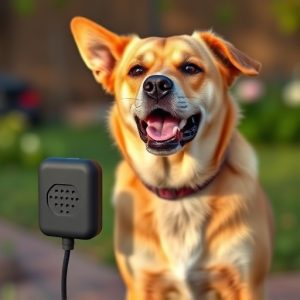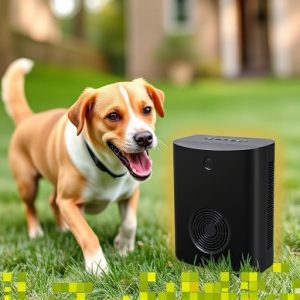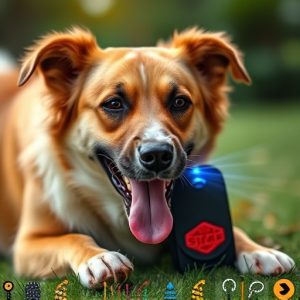Dog Repellent Devices: Safety, Science, & Effective Choices
Dog repellent device compliance testing is essential for ensuring safety, effectiveness, and adheren…….
Dog repellent device compliance testing is essential for ensuring safety, effectiveness, and adherence to regulations. Independent tests verify these devices meet strict standards, deterring dogs without harming them. By focusing on canine behavior and leveraging technology like ultrasonic sounds or static electricity, these devices offer humane solutions. Prioritize products with compliance testing, intuitive controls, durable designs, and eco-friendly features for effective and safe dog management. Top brands like PetSafe, Dogtime, and Scatmat lead the market with innovative, tested, and legal dog repellent solutions.
“Discover the future of pet management with a focus on Humane Dog Deterrent Electronic Devices. This comprehensive guide explores the evolving landscape of dog repellent technology, highlighting its safety and effectiveness through crucial Compliance Testing. Uncover the science behind these innovative devices, consider key factors for informed selection, and gain market insights into leading brands shaping the industry. From understanding device functionality to ensuring pet safety, this article offers a thorough overview of Dog Repellent Devices and Compliance Testing.”
- Understanding Dog Repellent Devices: A Comprehensive Overview
- The Importance of Compliance Testing for Safety and Effectiveness
- Uncovering the Science Behind Dog Deterrent Technology
- Key Factors to Consider When Evaluating a Dog Repellent Device
- Market Insights: Popular Brands and Their Product Features
Understanding Dog Repellent Devices: A Comprehensive Overview
Dog repellent devices have gained popularity as a humane alternative to traditional, potentially harmful methods of keeping dogs away from certain areas. These electronic devices emit sounds, vibrations, or sprays designed to deter dogs without causing them physical harm. Understanding their functionality and effectiveness is crucial for responsible use.
Compliance testing plays a vital role in ensuring these devices meet specific safety standards and regulations. Dog repellent device compliance testing involves rigorous evaluations to guarantee their reliability, safety, and adherence to industry norms. By subjecting these devices to various tests, manufacturers can certify their performance, ensuring they remain humane and effective over time. This process also helps consumers make informed choices, knowing the products they purchase have undergone thorough scrutiny.
The Importance of Compliance Testing for Safety and Effectiveness
In the world of dog repellent devices, safety and effectiveness are paramount. That’s why Dog Repellent Device Compliance Testing plays a crucial role in ensuring these electronic tools serve their purpose while minimizing potential harm to pets and humans alike. Independent testing by recognized authorities verifies that these devices meet specific safety standards, such as controlling electrical output to prevent injury.
Compliance testing also ensures the device’s effectiveness against targeted behaviors, like dog barking or aggressive posturing. By confirming these aspects, consumers can be confident in their purchase, knowing it not only respects animal welfare guidelines but also delivers on its promise of deterring unwanted canine behavior in a humane and safe manner.
Uncovering the Science Behind Dog Deterrent Technology
The science behind dog deterrent technology involves a deep understanding of canine behavior and sensory perception. Electronic dog repellents are designed to trigger an aversive response in dogs without causing harm or lasting discomfort. These devices often employ ultrasonic sounds, static electricity, or a combination of both to deter unwanted behavior like barking, aggression, or marking territory. The key lies in the precise activation—the technology must respond instantly to specific behaviors, ensuring it’s only triggered when necessary, thereby avoiding unnecessary stress on pets and peace of mind for owners.
Compliance testing plays a crucial role in developing these devices. Rigorous testing ensures that the repellents meet safety standards and are effective yet humane. It involves subjecting the devices to various conditions, behavior simulations, and intensity levels to verify their performance and reliability. By adhering to strict guidelines, dog repellent device manufacturers can ensure their products are not only compliant with regulations but also provide a humane solution for managing canine behaviors.
Key Factors to Consider When Evaluating a Dog Repellent Device
When evaluating a dog repellent device, several key factors come into play. Firstly, compliance testing is paramount to ensure the product adheres to safety standards and regulations. This includes checking for electromagnetic interference with other devices and ensuring it poses no harm to both dogs and humans. Additionally, consider the device’s effectiveness; look for products that have been independently tested and proven successful in deterring dogs without causing distress or injury.
The user experience is another significant aspect. A good dog repellent device should be easy to set up, use, and adjust, with intuitive controls and a design that fits seamlessly into your outdoor space. Durability is also crucial; the device needs to withstand various weather conditions and potential contact with enthusiastic canines. Lastly, consider the environmental impact—opt for eco-friendly models whenever possible.
Market Insights: Popular Brands and Their Product Features
In the ever-growing market for dog deterrents, numerous brands have emerged, each promising effective and humane solutions. Top contenders include PetSafe, Dogtime, and Scatmat, known for their innovative and reliable products. PetSafe’s range offers a combination of ultrasonic sounds and gentle sprays, while Dogtime specializes in remote-controlled systems that allow precise activation based on specific behaviors. Scatmat’s unique mat design encourages positive training by rewarding dogs for choosing alternative paths.
All these brands undergo rigorous Compliance Testing to ensure their devices meet safety standards and effectively deter dogs without causing harm. This testing involves assessing the device’s performance, reliability, and impact on animal welfare, ultimately giving pet owners peace of mind and ensuring the products’ adherence to legal guidelines, such as those set by the ASPCA (American Society for the Prevention of Cruelty to Animals).
In conclusion, selecting a humane dog deterrent electronic device involves a careful balance between safety, effectiveness, and compliance testing. Understanding the science behind these technologies empowers pet owners and professionals alike to make informed decisions. By considering key factors such as design, active ingredients, and user reviews, individuals can navigate the market with confidence, ultimately choosing a product that not only deters unwanted canine behavior but also aligns with industry standards for safety and performance, ensuring a peaceful coexistence between humans and their four-legged companions.


